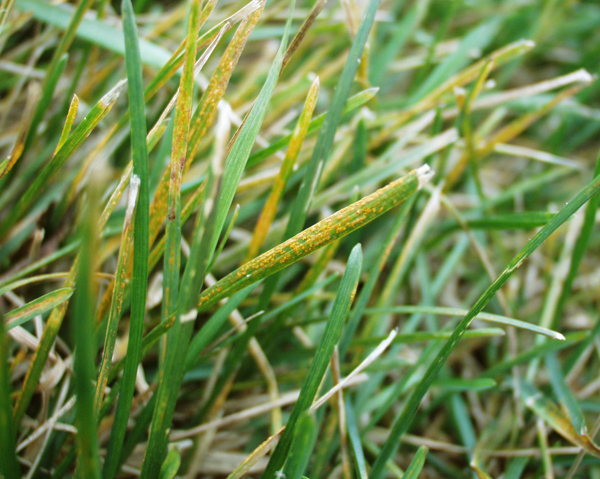A Rusty Orange Dust in Lawns
I recently got my first question about a rusty orange dust in a person’s lawn. This is a fairly common question in the late summer and early fall. Are you seeing this phenomenon in your lawn?
The “dust” comes off the blades and onto shoes as you walk or mow. This turf disease is aptly named after what it looks like – rust.
Rust typically shows up after a period of slow growth of turf, associated with summer stress or some other stressing factor, as has been the case in recent weeks.
A variety of fungi cause rust diseases. Rust has what can be considered a slow infection cycle, and tall, slow-growing perennial ryegrass and Kentucky bluegrass are most susceptible.
Dr. Rick Latin, Professor Emeritus of Plant Pathology at Purdue, said in a Purdue Turf Tips post, “Ample precipitation favors dispersal of rust spores and subsequent infection of susceptible turf.” He said the disease is largely cosmetic, but the orange spores that are easily dislodged from leaf surfaces can be more than a nuisance, covering shoes, pets, and lawnmowers with a rusty residue.
He said that new spring-seeded lawns that lose vigor during heat and drought conditions of summer may be severely damaged by rust.
Latin said that one question about rust is asked more than any other—will it harm my dog? “The answer is no…and no further explanation is necessary,” he said.
While it seems like a logical course of action, homeowners may wonder if collecting clippings will help. “The answer here is ‘no’ also,” he said. “There are tens of millions of rust spores in the air--inoculating your lawn every day.” He added that because the rust pathogen must complete every stage of its life cycle on a LIVING host, spores on your clipped grass blades will soon die, and no longer be a threat to the yard.
“If the lawn is in need of any kind of renovation, now is the time to consider Kentucky bluegrass cultivars with rust resistance,” Latin said. “Many of the newest cultivars are only slightly affected by the rust pathogen.” Local lawn care professionals or garden stores will have access to information about rust-resistant grass.
For most homeowners, the best course of action is encouraging healthy, fast-growing turf. A vigorous turf stand will tend to “outgrow” the effects of rust in a short time. Good courses of action for homeowners include deeply watering once per week in the absence of rain, very lightly fertilizing with nitrogen (0.2-0.5 pounds of N per 1,000 square feet), and regular mowing. Avoid fertilizing if the extended forecast is devoid of rain and hot. Professional lawn care companies have chemical options for rust.
For more information, access Purdue Extension publication BP-110-W, authored by Latin, “Turfgrass Disease Profiles: Rust Diseases,” at www.edustore.purdue.edu.

Rust in turfgrass. Photo by Purdue University.
